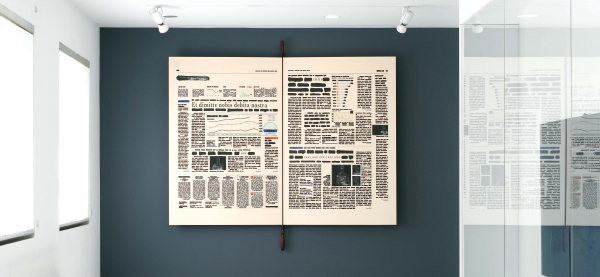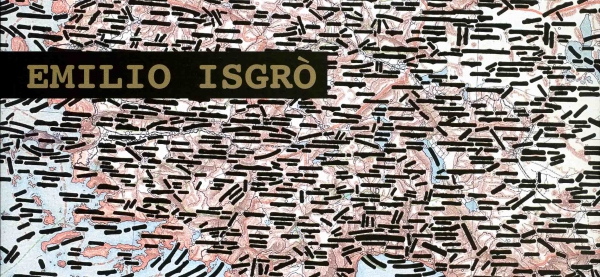Emilio Isgrò (Barcellona Pozzo di Gotto, Sicily, October 1937) is an Italian artist and writer, noted for his use of the erasure technique in his art works.
Isgrò made his literary debut in 1956 with the poetry collection Fiere del Sud (Arturo Schwarz Editore). In 1964 he first began erasing encyclopaedias and other texts, making his personal contribution to the birth and development of visual poetry and conceptual art. In 1966, during his first solo show at the Galleria Traghetto in Venice, he published Dichiarazione I , defining his conception of poetry as ‘general art of the sign’. He published the volume of poems L'età della ginnastica (Mondadori).
In 1976 the first retrospective of his work was offered by the Centro Studi e Archivio della Comunicazione (CSAC) of Parma. In 1977 he was awarded with the first prize at the XIV Bienal de São Paulo in Brazil. In 1977 he took part in the Venice Biennale, returning there in 1978, 1986 and 1993. He was one of a group of artists featured in the exhibition Contemporanea (1973), curated by Achille Bonito Oliva in the underground parking of Villa Borghese in Rome. The following year saw the publication of L'avventurosa vita di Emilio Isgrò nelle testimonianze di uomini di stato, scrittori, artisti, parlamentari, attori, parenti, familiari, amici, anonimi cittadini (Il Formichiere), nominated fo the Strega Prize.
In 1979 he presented Chopin, an installation for 15 pianos, at Rotonda della Besana in Milan.

In 1982 his Gibella del Martirio and San Rocco legge la lista dei miracoli e degli orrori were performed in Gibellina. During three consecutive seasons, his Sicilian trilogy Orestea di Gibellina was also performed in Gibellina at the Festival Internazionale delle Orestiadi.
In 1985 the Teatro alla Scala commissioned him to create the multimedia installation La veglia di Bach within the Milan church, San Carpoforo. In 1986 he created the installation L'ora italiana at the Civic Archaeological Museum in Bologna, commemorating the victims of the terrorist bomb attack at the city’s railway station on 2 August 1980. In 1989 he published the novel Polifemo (Mondadori), working, at the same time, on a new theory of erasure with Teoria della cancellatura (Galleria Fonte d'Abisso).
Isgrò’s work was exhibited in The Artist and the Book in Twentieth-Century Italy, in 1992-1993 at the Museum of Modern Art (MoMA) in New York and in 1994 at the Peggy Guggenheim Collection in Venice. In 1994 he also published the novel L'asta delle ceneri (Camunia) and returned to poetry with the collection Oratorio dei ladri (Mondadori).In 1998 he donated the gigantic sculpture Orange Seed to his Sicilian birthplace, Barcellona Pozzo di Gotto, as a symbol of social and civil rebirth of Mediterranean countries.

In 2001 Palermo dedicates to Isgrò a major retrospective, Emilio Isgrò, using as exhibition space the unfinished church of Santa Maria dello Spasimo. With Le api della Torah he also began a cycle of work featuring insects. In 2002 he published another book of poetry, Brindisi all'amico infame (Aragno), which was shortlisted for the Strega Prize and won the San Pellegrino Prize for poetry awarded by the Italian town of San Pellegrino Terme.
In 2007 he collected inside the volume La cancellatura e altre soluzioni (Skira) essays and writings previously published in various newspapers and magazines, as a critical and theoretical legacy of his artistic activity. The following year an important exhibition of his work, titled Dichiaro di essere Emilio Isgrò, was held at the Centro per l'arte contemporanea Luigi Pecci in Prato.
In 2009 he exhibited in Milan at Palazzo Stelline, and the following year in Marsala, Sicily, with Disobbedisco. Sbarco a Marsala e altre Sicilie. In 2010 it has been presented the exhibition Var ve yok opened at the Taksim Sanat Galerisi in Istanbul, while his fourteen Codici ottomani were exhibited at the Boghossian Foundation in Brussels.
The same year Boxart gallery in Verona presented the project Costituzione cancellata, curated by Marco Bazzini.
In May 2011 he presented the installation L'Italia che dorme (La Costituzione cancellata) at the Galleria d'Arte Moderna in Rome, as part of the celebrations for the 150th anniversary of the unification of Italy. The same year Bocconi University in Milan inaugurated his Cancellazione del debito pubblico.
In June 2013 the Galleria d'Arte Moderna in Rome presented Modello Italia, an important recollection of Isgro’s works. In 2014 for the Pecci centre of Prato Isgrò created and performed a project called Maledetti toscani, benedetti italiani, which was divided in three different times. He interpreted the role of Curzio Malaparte on the stage of the Metastasio Theatre; he erased eleven important Toscan persons for a specific show at Museo di Palazzo Pretorio and he realized a video performance called Le api di Lipari.
In 2013 Maretti editore published Come difendersi dall'arte e dalla pioggia, curated by Beatrice Benedetti.
Artist of the year of Radio3 in 2014, in May his self-portrait Dichiaro di non essere Emilio Isgrò was acquired by the Galleria degli Uffizi in Florence, while in Milan his site specific Grande cancellatura per Giovanni Testori was installed in Piazza Gino Valle, within the newly reformed Portello district.
In 2015 he created the Seme dell’Altissimo, a 7 metres height marble sculpture installed at Expo Milano.
From June to September 2016 Milan paid a tribute to Emilio Isgrò with a major retrospective held simultaneously in multiple locations: Palazzo Reale, Gallerie d'Italia and Casa del Manzoni.
In 2017 Isgrò made his debut in London and Paris with two important retrospective held at Tornabuoni Gallery.
The same year, three of his important works (among them the celebrated installation of Il Cristo cancellatore of 1968) have become part of the permanent collection of the Centre George Pompidou of Paris.

In 2018 Isgrò presents the monumental work “Monumento all’Inferno”, specifically created for the Milanese University IULM.
In April he exhibits a refined selection of his works in Belgium, at the MDZ Art Gallery, in a double solo show together with Christo.

In the summer, Lettere was an exhibition-dialogue between the artist and Osvaldo Licini at Centro Studi Casa Museo Osvaldo Licini at Monte Vidon Corrado.

In September 2019 Fondazione Giorgio Cini of Venice held a major retrospective of Emilio Isgrò, curated by the critic Germano Celant. On the occasion Treccani published the monograph Emilio Isgrò, curated by the same Germano Celant, offering a recollection of the entire artistic career of Isgrò, introduced by a long interview with the art critic.
In December the city of Milan rewards Isgrò with an important demonstration of civic merit: the Ambrogino d’Oro.


